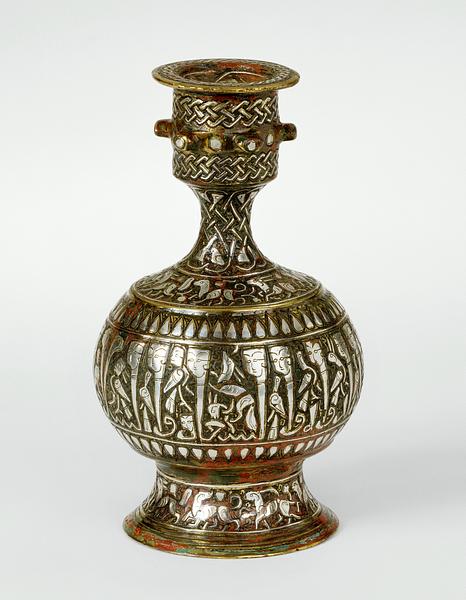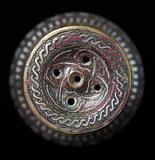Rosewater sprinkler, cast bronze, engraved and inlaid with silver
Eastern Iran or Afghanistan; c. 1200
H: 12.8; Maximum diam: 7.8 cm
There was a sharp drop in the mining of precious metals in around 1100. To take the place of solid objects, a technique was devised by which bronze pieces could be inlaid with a thin layer of copper, silver, or gold.
The many different bands with silver inlays make this rosewater sprinkler a little masterpiece. Most striking is the widest band with the Arabic inscription expressing various good wishes. The cursive script is “animated” with upstrokes that end in faces, which seem to enter into a dialogue with the animals and mythical creatures that fill out the interspaces so imaginatively.
Inv. no. 65/1998
Published in:
Spink & Son: Passion and tranquility: Indian & Islamic works of art, London 1998, cat.no. 1;
Kjeld von Folsach: Art from the World of Islam in The David Collection, Copenhagen 2001, cat.no. 495;
Finbarr Barry Flood: “Between cult and culture: Bamiyan, Islamic iconoclasm, and the museum” in Art Bulletin, 84:4, 2002, p. 644;
Sheila S. Blair and Jonathan M. Bloom (eds.): Cosmophilia. Islamic Art from the David Collection, Copenhagen, McMullen Museum of Art, Boston College, Boston 2006. cat.no. 113;
Joachim Meyer: Sensual Delights: Incense Burners and Rosewater Sprinklers from the World of Islam, The David Collection, Copenhagen 2015, cat.no. 17;
Finbarr Barry Flood: "Signs of silence: epigraphic erasure and the image of the word" in Christiane Gruber (ed.): The image debate: figural representation in Islam and across the world, London 2019, fig. 3, p. 48;
Joachim Meyer: “Ornament or symbol. Around an early group of silver amulet cases in the David Collection” in Journal of the David Collection, 2021, 5, fig. 9, p. 15;
Joachim Meyer, Rasmus Bech Olsen and Peter Wandel: Beyond words: calligraphy from the World of Islam, The David Collection, Copenhagen 2024, cat. 29, p. 161;


